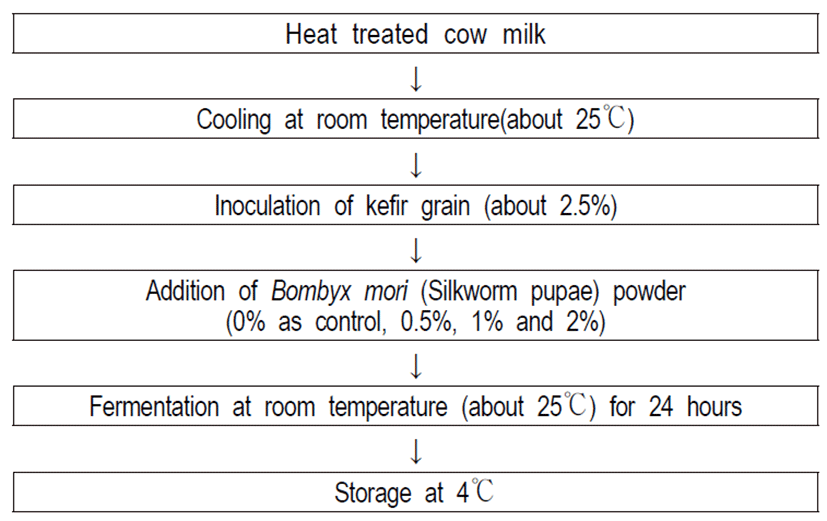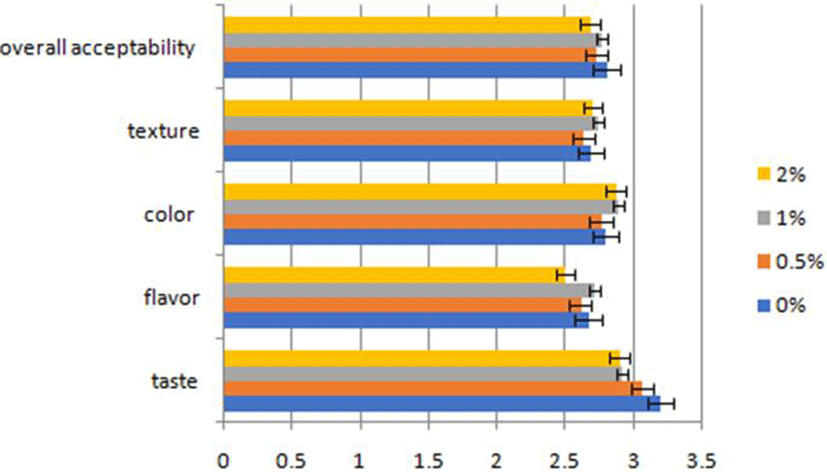Introduction
Food production had a considerable environmental impact and future food systems need to take this into account(CFS, 2009; Lang and Barling, 2013; van Huis, 2017). In particular the production of meat, especially ruminant meat, was more and more debated in view of environmental, societal or food safety and animal welfare concerns(van Huis, 2015). Until now, an inventory of the edible insect species eaten from all over the world yielded more than about 2,000 species, and edible insects had been consumed in more than 110 countries over the world(Rumpold and Schlüter, 2013; Jongema, 2017). Especially, the high proportion of edible insects was Acheta domesticus (Cricket), T. molitor (Mealworm), and so on(Nowak et al., 2016). Among various edible insects, Bombyx mori (Silkworm pupae) was a major item among edible insects and were mainly consumed in Asia area (Baker et al., 2016). However, the availability of Bombyx mori (Silkworm pupae) was very low than other edible insects(Park et al., 2017). Hence it urgently needs to utilize Bombyx mori (Silkworm pupae) so as to develop the high value-added commercial products.
Recently, kefir originating from the Caucasian Mountains has gained popularity as a health promoting beverage and source of organisms (Vinderola et al., 2006; Walsh et al., 2016). Kefir has been associated with various health benefits through examining the mechanisms (Liu et al., 2012). According to several studies, Kefir had demonstrated ACE inhibitory activity, the ability to improve levels of serum cholesterol, and immunomodulatory characteristics, and so on (Maeda et al., 2004; Jeong et al., 2017). Additionally, among various lactic acid bacteria contained kefir, Lactobacillus kefiri, L. kefiranofaciens, and L. kefiranofaciens had shown beneficial effects for health in vivo(Chen et al., 2012).
Therefore, the purpose of this study was to manufacture the protein-fortified kefir added with Bombyx mori (Silkworm pupae) with improving the sensory evaluation. In this experiment, among various physicochemical characteristics of the protein-fortified kefir produced with Bombyx mori (Silkworm pupae), pH and sensory evaluation were analyzed.
Materials and Methods
Dried Bombyx mori (Silkworm pupae) was purchased from Sworm Co. (Korea), and then was grinded into powder using manual grinder, passed through a 25 mesh sieve, and stored in polyethylene bags at -20℃ until use.
The kefir grains were obtained from Center for One Health, College of Veterinary Medicine, Konkuk University in Seoul, Korea. And kefir grains were used to ferment milk for producing protein-fortified kefir (Fig. 1). Protein-fortified kefir samples were added with different concentration rates of Bombyx mori (Silkworm pupae) powder (0% as control, 0.5%, 1%, and 2%). And then the protein-fortified kefir samples were stored at 4℃.

The value of pH was measured with a digital pH meter (Orion Star A211, USA). Before measuring pH, the detector was calibrated with pH 4 and pH 7 buffer, respectively. All treatments were performed in triples.
The sensory evaluation was carried out by 10 trained panelists between 20 and 40 years of age. The samples were coded with three digit numbers and randomly served at 8 to 10℃ in plastic cups (10 mL). All assessors completed a test assessment form to compare the five sensory attributes (appearance, flavor, taste, and overall acceptability) by using a five-point hedonic scale (1, extremely poor; 2, poor; 3, fair; 4, good; 5, excellent).
For all data analyses, GraphPad Prism 5 (USA) was used. Two separate experiments with duplicate assays were performed. Analysis of variance (ANOVA) was used to determine the significance of main effect. Duncan's multiple range test was used to determine differences between means. Statistical significance was considered at p<0.05.
Results and Discussion
In this study, after the fermentation of kefir premix, the pH was decreased to about 4.49 The pH value of the protein- fortified kefir added with Bombyx mori (Silkworm pupae) powder (0.5%, 1%, and 2%) showed 4.51, 4,50, and 4,52, respectively. While, the titratable acidity (TA) contents of the protein-fortified kefir added with Bombyx mori (Silkworm pupae) powder (0%, 0.5%, 1%, and 2%) showed approximately from 0.91 to 0.92% (data not shown). Then, the pH and TA value between control keifr and kefir added with Bombyx mori (Silkworm pupae) powder (0.5%, 1%, and %) were similar, and there was no significant difference of TA and pH between control group and treated group.
The sensory evaluation of the protein-fortified kefir was evaluated by 10 trained panelists of ages 20 to 40 years, and the results are summarized in Fig. 2.

The protein-fortified kefir was prepared with Bombyx mori (Silkworm pupae) powder at concentrations of 0, 0.5, 1, and 2%, respectively. According to statistical analysis of the sensory properties, there was not any significant difference in overall acceptability, texture, and color, but in flavor and taste between control group and treated group (p<0.05).
The taste scores for the protein-fortified kefir with Bombyx mori (Silkworm pupae) powder (0% as control, 0.5%, 1%, and 2%) showed 3.20, 3.06, 2.91, and 2.89, respectively. The flavor scores of the protein-fortified kefir with Bombyx mori (Silkworm pupae) powder (0% as control, 0.5%, 1%, and 2%) showed 2.66, 2.61, 2.71, and 2.50, respectively. The color scores of the protein-fortified kefir with Bombyx mori (Silkworm pupae) powder (0% as control, 0.5%, 1%,
and 2%) showed 2.79, 2.76, 2.89, and 2.87, respectively. The texture scores of the protein-fortified kefir with Bombyx mori (Silkworm pupae) powder (0% as control, 0.5%, 1%, and 2%) showed 2.69, 2.63, 2.74, and 2.70, respectively. And the overall acceptability scores of the protein-fortified kefir with Bombyx mori (Silkworm pupae) powder (0% as control, 0.5%, 1%, and 2%) showed 2.80, 2.72, 2.76, and 2.68, respectively. Therefore, the scores of all categories except color were the same or lower in Bombyx mori (Silkworm pupae) powder-containing protein-fortified kefir with 0.5%, 1%, and 2% among the experimental group compared with the control group (0%).
To summarize the results of this experiments, the addition of Bombyx mori (Silkworm pupae) powder did not affect the sensory properties such as overall acceptability, texture, and color compared to control group without addition of Bombyx mori (Silkworm pupae) powder. While, the flavor and taste showed high scores according to the addition amount of Bombyx mori (Silkworm pupae) powder.
According to several previous studies (Park and Park, 1986; Jeon and Park, 1992), the defatted Bombyx mori (Silkworm pupae) was a excellent protein source when it was added to emulsified food, and also the enzymatically hydrolyzed Bombyx mori (Silkworm pupae) could improve the retention capacity of water and oil to compare with non-treated Bombyx mori (Silkworm pupae). And Park et al. (2017) reported that the combination of Bombyx mori (Silkworm pupae) and transglutaminase could be a new functional and nutritional resource for meat products.
Hence, it is necessary to use Bombyx mori (Silkworm pupae) to upgrade its functionality as food additives. Especially, Bombyx mori (Silkworm pupae) proteins are efficiently worked in wound dressings, hepatoprotective and antiapoptotic activity, antigenotoxicity, regulation of blood glucose and lipids, anticancer agent, and so on (Lang and Barling, 2013; Park et al., 2017). Therefore, Bombyx mori (Silkworm pupae) could be utilized as food supplement and its enormous proteins open the new dimension for biomedical science (Kumar et al., 2015; van Huis, 2017).
Conclusively, the protein-fortified kefir added with 0%, 0.5%, 1%, and 2% of Bombyx mori (Silkworm pupae) powder showed the increase of TA but decrease of pH. Also the protein-fortified kefir containing 0.5~2% concentration of Bombyx mori (Silkworm pupae) powder received higher scores for color and texture in the sensory properties. In the future, additional researches are essential for manufacturing the fortified kefir with addition of Bombyx mori (Silkworm pupae) powder so as to upgrade the efficiency for human health.
